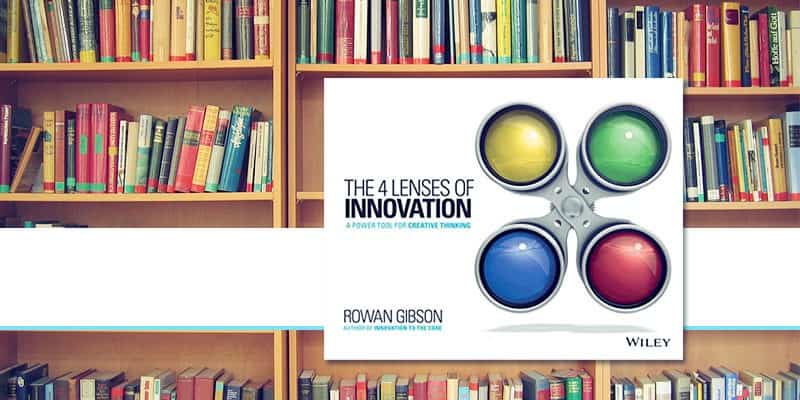You are here
The Innovation Engine Podcast: Breakthrough Insights from: Rowan Gibson – Part 1

This is a transcript and audio file from the popular podcast “The Innovation Engine”, hosted by Will Sherlin, featuring an interview with Rowan Gibson, author of “The Four Lenses of Innovation.”
“Welcome to the Innovation Engine podcast, I’m Will Sherlin, and on this week’s episode, we’ll be looking at the 4 lenses of innovation – what the 4 lenses are and how they can be used to drive corporate innovation, and how they can be employed to emulate the mind of the innovator.
Here with us today to discuss all that and more is Rowan Gibson, a world-renowned innovation expert who has served as a keynote speaker on the subject of innovation in 60 countries around the world. Rowan is the internationally bestselling author of the forthcoming book The Four Lenses of Innovation. He has previously written two major books on corporate innovation and business strategy: Innovation to the Core and Rethinking the Future, which is published today in over 20 languages. Rowan is also the co-founder of Innovation Excellence.com, the most popular innovation website in the world, built by an international group of over 26,000 members from 175 countries. And if you’ve been a long-time listener of this podcast, you’ll remember him from the 13th episode of “The Innovation Engine,” when he talked about Building a Blueprint for Innovation.
Let’s start off today talking about your latest book, The Four Lenses of Innovation, which will hit bookstores the day this podcast goes live, March 2nd. What are some of the main takeaways you hope readers get from the book?
Well, first that we can all be innovators. We used to look at the people that sort of make it to the front cover of Fast Company and think they’re just kind of special, right? They’re more creative than the rest of us. They have this entrepreneurial gene – this ability to spot big new opportunities before anyone else and then take these huge risks to make them happen. You know, someone like Jeff Bezos, or Richard Branson, or Elon Musk. So there’s this guy grinning at me from the front cover of Fast Company or Forbes or whatever and looking all superhuman – you know, the super achiever. But it turns out that innovators are mere mortals just like you and me. It reminds me of the Wizard of Oz. When you look behind the curtain you find out there’s this little person sitting there who is just as human as we are. So what’s their secret sauce? What are the innovators doing differently? And how can we do what they do?
The great news is that it’s really quite simple. It’s all about developing the right mental perspectives. It’s essentially about the lenses we use to look at the world around us, and at particular situations or problems. So the main takeaway from the book is that we can all discover great opportunities for innovation if we can learn to look at the world the same way innovators do. And that’s nowhere near as hard as it sounds.
You know, one of the things that strike me when I read all these after-the-fact stories about great cases of innovation in the business press is that nobody tries to analyze the thinking processes that might have led to them. They don’t ask “What was this person thinking? How did he or she spot some big opportunity that nobody else seems to have seen? What was the innovator’s angle of view?”
So this book is essentially about understanding the thinking patterns that lead innovators to their big ideas and then emulating those thinking patterns – actually using these perspectives (or I call them “lenses”) systematically to uncover new insights and ideas that are out there just waiting to be discovered. It’s about reverse-engineering the mind of the innovator.
I have come to believe that you can learn to innovate, just as you can learn to play the piano, or learn to cook or learn anything else. For some people, it comes more naturally, of course. Either by nature or by nurture (or some fortunate interaction of both), some individuals have managed to develop their innovation skills to a much higher degree than others. But creativity is not some rare mystical power that’s possessed by only a few specially gifted people who were simply born different from the rest of us. It’s a skill that is innate in all human beings, and always has been, from the time somebody first picked up a stone and figured out how to use it as a tool. So all of us have the mental capacity for idea generation and imaginative problem-solving, and all of us can improve our creative abilities.
Think about the implications this has for companies. If you can really teach people the skills and the tools of innovation – if you can teach literally anyone, anywhere to develop the mind of the innovator – imagine how that would unlock the brainpower of the whole organization. Imagine how that would unleash creativity. And that’s the promise – the key take-away – of this book. The subtitle is “A power tool for creative thinking”. And that’s what I believe it is. I think it’s going to dramatically enhance our capacity for innovation – both as individuals and as companies.
In the next part, we will have a look at innovation through something of a historical lens.



































































EgyptInnovate site is not responsible for the content of the comments